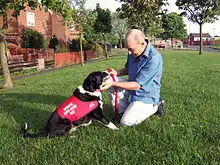Diabetes alert dog
A diabetic alert dog is an assistance dog trained to detect high (hyperglycemia) or low (hypoglycemia) levels of blood sugar in humans with diabetes and alert their owners to dangerous changes in blood glucose levels.[1] This allows their owners to take steps to return their blood sugar to normal, such as using glucose tablets, sugar and carbohydrate rich food. The dog can prompt a human to take insulin.[2]

| Disability |
|---|
|
When owners with diabetes begin to experience hypoglycemia, the detection dogs perform a predetermined task (e.g. bark, lay down, sit) to inform the person.[3] Dogs may be directly smelling something related to the abnormal glucose concentration, or may be reacting to the owner's symptoms which are caused by hypoglycemia, such as sweating or shaking.[4]
History
The first dog trained to detect hypoglycemia was a Californian dog called Armstrong in 2003.[5] In 2009, a dog named Tinker from Durham City became the first self-taught British assistance dog to be officially registered for a type 2 diabetic owner. He was able to give his owner Paul Jackson up to half an hour warning before an attack occurred.[6]
Training
Diabetic alert dogs are trained to detect blood glucose changes using the saliva of diabetic patients. The diabetic person collects samples using gauze or dental cotton during a time when their blood sugar is just starting to get too low, or too high. Samples must be collected when the patient has not eaten within 30 minutes, brushed their teeth or used anything with a strong smell such as mouth wash in order to get the strongest scent for diabetes alert. Once the samples are collected, they are frozen and used in training dogs to alert to blood sugar changes. [7][8]
Like all service dogs, diabetic response dogs and diabetic alert dogs must meet the ADA standards of behavior for public access, so along with specialized training to assist people with blood glucose issues, these dogs are also trained to behave properly in public spaces.
Reliability
Dog users were very satisfied with their dogs although tests of dogs showed low reliability.[9]
See also
References
- Peters, Sharon L. (2011). "Dogs alert diabetes patients when blood sugar is off". USA TODAY.
- Roberts, Jacob (2015). "Sickening sweet". Distillations. 1 (4): 12–15. Retrieved 20 March 2018.
- Cooper, Georgina (22 June 2009). "British dogs trained to sniff out diabetes". Reuters. Retrieved 25 May 2011.
- "Can Diabetes Alert Dogs Help Sniff Out Low Blood Sugar?". NPR.org. 29 July 2016. Retrieved 2017-11-12.
- "Armstrong". Guinness World Records: Amazing Animals: Packed full of your Most-Loved Animal Friends. Guinness World Records. 2017. p. 201. ISBN 9781912286249.
- "Dogs Smell Diabetic Attacks Coming". National Geographic. 2 June 2009. Retrieved 2017-11-12.
- "Diabetic Alert Dog Training: How to collect saliva samples for training". 22 Aug 2016. Retrieved 2017-12-04.
- "Service dogs for diabetics or just pricey pets?". 10 Feb 2015. Retrieved 2017-12-04.
- Los, Evan A.; Ramsey, Katrina L.; Guttmann-Bauman, Ines; Ahmann, Andrew J. (2016-08-28). "Reliability of Trained Dogs to Alert to Hypoglycemia in Patients With Type 1 Diabetes". Journal of Diabetes Science and Technology. 11 (3): 506–512. doi:10.1177/1932296816666537. ISSN 1932-2968. PMC 5505410. PMID 27573791.